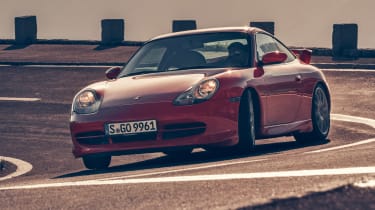Porsche 911 GT3 (996, 1999-2005) review – the purest GT3 of them all?
Getting the green light for the original 911 GT3 was something of a miracle. This is the story of how it happened, and how that same car drives today

Can it really be 20 years? Seems hard to believe so many summers could have passed since the 996 GT3 was introduced to the world’s motoring press in a somewhat low-key launch in rural Germany. But two decades it most certainly is. A fact backed up by a catalogue of vivid memories gathered during the many hundreds of hours and thousands of miles this magazine has spent behind the wheel of every iteration of GT3 since 1999.
We could have drawn together all of those cars for a definitive GT3 gathering, but so sizeable is that body of work we would be required to dedicate an entire magazine issue to the task. Not a bad idea, I suppose… That or we’d have to skim over them with scant regard for depth of detail. Not something that sits well with us here at evo, for it would be tantamount to an insult to arguably the greatest and most consistently dominant series of high-performance cars in living memory.
So, what to do? Thankfully that question was answered for us by Porsche Switzerland, which decided the GT3’s 20th anniversary was too significant not to celebrate in style. It was an inspired decision, for although the country has a justified reputation for enthusiastic policing of its speed limits, once you head for the mountains and hit the switchbacks, there’s a bit more freedom to enjoy yourself.
More reviews
In-depth reviews
- Porsche 911 Carrera GTS T-Hybrid review – the first hybrid 911 is one of the best
- Used Porsche 911 (991, 2011 - 2018) review – should you buy the unloved 911?
Long term tests
Reviews
- New Porsche 911 Turbo S review – McLaren Artura performance with four seats
- RML GT Hypercar review – the Porsche 911 taken to the ultimate extreme
- Used Porsche 911 (997, 2004 - 2012) – the ultimate sweet spot 911
- Porsche 911 Turbo S (992.1, 2020 - 2024) review – Stuttgart’s supercar slayer
- Porsche 911 3.2 Carrera (1984 - 1989) review – flawed but furiously charming
Part of me wishes we’d laid our hands on an early GT3 in the UK and driven out, but the flight to Zürich means we can leapfrog a tedious and almost entirely meaningless eight-hour drive from Calais. Besides which, evo’s budget wouldn’t have stretched to putting photographer Dean Smith and myself up in the rather splendid Chedi Andermatt.
The road route Porsche Switzerland has in store for Dean and me is something to make our spirits soar: a clutch of mountain passes including the Gotthard, Nufenen, Grimsel and Susten. And all on our doorstep. If there’s a driving paradise, I think it would be a lot like this. Combine with a Guards Red Gen 1 996 GT3 and you’ve got the makings of more unforgettable memories.
Before we head into the mountains it’s worth pausing to consider how the GT3 first came to be. It’s a story I learned in detail a few years back, when I was fortunate to sit down with Hartmut Kristen – father of the GT3 – in an interview conducted for the Porsche fanatic’s quarterly publication of choice, 000. I recall the conversation started with something of a bombshell, when Kristen matter-of-factly revealed the project received a lukewarm reception and could very easily not have happened at all: ‘I remember the exact words when I went to request the go-ahead for GT3: “Yes, you can do it, but only if it doesn’t hurt the brand…”’ You really couldn’t make it up.
Now, we all know that despite our reverence for the last of the air-cooled 911s, when it committed to building the 996 and the Boxster, Porsche was far from the profit-generating powerhouse it is today. In fact it was in dire straits. Those 993s cost a fortune to build, and with no economies of scale or platform/powertrain sharing to achieve all-important efficiency, Porsche didn’t just need to reinvent and expand its range, it needed to implement a root-and-branch cultural transformation if it was to guarantee the company’s survival.
Fried-egg headlights may have got diehards hot under the collar, but this most visible manifestation of Porsche’s battle for profitability was just the tip of the iceberg. So deep did the systemic changes run that not only were key structural underpinnings, body panels and the 996’s 3.4-litre flat-six motor also derived from the Boxster, but the all-new, built-to-a-price water-cooled engine had no development headroom built into it for forced induction or the rigours of racing.
This was Porsche as it had never been seen before. A company run by cold pragmatists who scanned spreadsheets and counted beans, not passionate engineers who pored over dyno plots and sweated bullets for hard-won brake horsepower.
Thinking back to the very early days of the 996, that cultural change was clear. Yes, they were still unique cars compared to their peers, special in feel and blessed with a true breadth of capability, but there was a palpable sense they had been de-contented in terms of labour and materials (especially on the interior) and were mechanically homogenised compared to the 993. Put simply, Porsche had bet its shirt on the 996 being built in genuine volume, even if it meant sacrificing the specialist derivatives that we clearly took for granted.
Had we known the internal struggle that was taking place within Porsche at the time the GT3 was eventually given the green light, we might have been more grateful for its existence. Instead, I recall a few of us attendees at the international press launch doing what journalists tend to do: immediately taking for granted the car before us and asking those responsible for its creation why the GT3 didn’t combine the welcome chassis and powertrain upgrades with the time-honoured RS method of intense lightweighting. Looking back, I’m surprised they didn’t slap us.
Then again, the ability to keep quiet and rise above is probably what saw them finagle the GT3 by a reluctant board of hard-nosed business people who required considerable persuasion – not to mention Kristen’s personal assurance – of the merits such a programme presented at such a testing time for the business.
The genius of the plan was rooted in Kristen and racing department legend Herbert Ampferer identifying that the nascent GT1 race engine offered a potential route to building faster and more focused 996 road cars. Given cash-strapped Porsche needed convincing to spend money on anything beyond building profitable series-production Boxsters and 996s, even the GT1 race programme was far from a dead cert. But if the money spent on its engine development could be amortised through a high-performance road car programme, well that might be a different story…
There were considerable packaging challenges to overcome before Hans Mezger’s water-cooled, dry-sumped ‘long-block’ GT1 motor would fit in the back of the 996, but Kristen and Ampferer were on a mission. Their solution was to mount the dry-sump tank on the engine block itself. Happy the lump would now fit, the upsides outweighed the downsides. Especially as the many carryover components between the old air-cooled and new water-cooled Mezger motors (block and crank to name but two) meant there was limited re-engineering required to develop engine variants for both GT3 and Turbo road cars. After due consideration, a cautious but expectant board duly signed off parallel programmes. Kristen & Co were in business!
It’s the naturally aspirated fruit of those labours that’s parked before us now. And boy does it look good. Two decades can be unkind to a car, but in this instance I’d suggest time has bestowed something extra special on the original GT3. I’m not entirely sure why it’s taken a while to register, but standing here in the crisp mountain air I’m rocked by how good the Gen 1 996 GT3 looks.
This epiphany is all the more powerful because I’m pretty certain that if we’re honest we’ve all considered it to look a bit blobby and soft around the edges at some stage over the last decade or so. I’m sure a lot of that sentiment is due to the aerokit, which featured on a lot of wannabe GT3s (sorry, Jethro). Now it’s hard to see anything but greatness. Even the fried eggs have attained a certain cult status.
For a car that’s so familiar, there’s a lot of things that stop you in your tracks. For me, it’s the stance that sets it apart. In terms of ride height it treads a (very) fine line between factory and aftermarket, but there’s enough precision to the pumped and preened look to suggest it was arrived at by people who know their stuff. Similarly, the way the front splitter skims the tarmac and the audacity with which the wheels are greased into the arches courtesy of a nudge of camber is magnificent.
One detail that’s easy to overlook, and was absent from the optional aerokit fitted to non-GT3s, is the subtle black Gurney flap on the trailing edge of the biplane rear wing. It’s only there to help trim the aero balance created by the GT3’s lower ride height, but its the cherry on top of what was a car that elevated the regular 996 Carrera to a level that proved Porsche was still serious about making sports cars.
It’s a good job our road route is a simple pass-to-pass loop, otherwise we’d be wholly reliant on flatnav as the GT3 is an infotainment-free zone. All you get is a world of basic black textured plastic, that familiar yet dated fan of overlapping crescent-shaped dials, a simple stereo and a stick-shift transmission. Likewise, there’s no switchable driver aids, which means no TC or ESC, just your right foot and grey matter to modulate the GT3’s power and torque against available traction. It might have been a major advancement over the air-cooled 993 in almost all respects, but in fundamental terms it remained a truly analogue experience.
Despite the many major differences ushered in by the 996, this GT3 is a fine reminder that these Gen 1 cars have their own feel. One distinct from those cars that came before it, and from those which followed. That’s why we get so attached to each generation and why so much thought is applied to which defines the breed. Of course, the answer is no one car from the GT3 canon can really hope to capture the DNA of a breed that has evolved so comprehensively over the last two decades, but there’s something pure and uncomplicated about the 996 that’s refreshing and exciting to be reminded of.
So too is its compactness – now more than ever in the wake of the 992. Devoid of display screens and multi-mode dynamic systems that shift and morph the feel, sound and response, there’s less to get to know, but the beauty of this old-school approach is a car that you connect with over a longer period of time. You settle into its behaviour, work with its fixed-rate damping and adapt and adjust your driving to the car and the road, not the car to the road or your mood.
Escaping to the towering pleasure of ascending one alpine pass after another, there’s ample opportunity to wring out the 360bhp 3.6-litre motor. Perhaps the only thing I regret about our drive being in the Porsche Museum’s red GT3 is that it’s not a Clubsport model, so therefore not fitted with the single-mass flywheel. Clubsport cars are less refined and chunter when stationary, but they enjoy a much-improved sense of snap when you crack open the throttle. This was one of the biggest differences between GT3 and regular Carrera, but Clubsport or not, the motor and the performance it offers does feel a little tame compared to today’s near-500bhp 9000rpm banshees.
The gearshift is via a mechanical linkage, not cable, so it has a quick, light action with an increased sense of tactility and precision. The clutch is firm but not too heavy, so it’s a pleasure to work with the machine to make progress rather than command it. And work with it you do on these mountain roads, with most of your time spent in the intermediate ratios, winding plenty of revs into the motor and feeling it come alive as you chase the red line. It’s not a prickly, energised, explosive machine in the manner of today’s GT3, but it rolls up its sleeves in a way that always marked it out from the basic Carrera.
It’s this relative softness compared to the current cars that takes some adjustment in your attitude and expectations, but once that shock has receded, what you’re left with is a rare degree of connection to the four contact patches. You feel for front-end bite rather than turn-in in the expectation of it being there. If it hasn’t hooked up you soon work the throttle to assist, a lift transferring some weight to the front, which generates a little more turn-in and helps rotate the car by getting the rearward weight bias to come into play.
It’s subtle stuff, but you’re never not aware of the physics in action, which is what separates 911s from other cars. Coax or cajole, steer by sleight of hand or sling it in, not only does the GT3 react and respond accordingly, but it feels appropriate.
The major difference is that you are engaged and enjoying yourself at lower speeds. This may sound like I’ve become an old fogey, but stepping back into the late-’90s is a reminder that you used to be able to get pleasingly close to a fast car’s limits without it being an exercise in jeopardy. What this doesn’t acknowledge is the 991 Gen 2 GT3’s utterly addictive speed and attitude. It has a sweaty-palmed, heart-pounding pace this Mk1 996 can only dream of. If I’m honest, the progenitor has little of that ferocity, and I’d be lying if I said I didn’t miss that. But taken in isolation the old car is a joy, because it lets you work it harder more of the time.
While Dean captures our statics images it gives me a chance to pause and consider that the above is a quality I have always associated with the Mk1 GT3. The speed and sharpness it possessed at launch may now be paler and less impressive in the context of 2020’s extraordinarily fast machines, but I have had some of the best drives of my life in these cars. Because of what they do and how they do it, and also for what they represent and what they ultimately unlocked within Porsche. In many respects the original GT3 could be seen as something of a talisman for Porsche. It was born in troubled times, but when production ceased in 2001, some 1868 cars had been built – roughly six times the initial forecast by Porsche’s marketing and sales team. Having exceeded expectations by such a margin, Kristen knew if the costs could be kept in check, Porsche boss Wendelin Wiedeking would not only sign off on development of a Gen 2 GT3, but he would want it to go to the United States. Given the Gen 1 never crossed the pond, this was a pivotal moment in the future of fast Porsches.
Few could have predicted just how remarkable the GT models shaped by the Motorsport Department would go on to become. Nor could anyone have truly imagined that the Cayenne and its spin-offs would have an even greater transformational effect on the complexion of Porsche’s business – and its profitability – than the Boxster and 996 for which Porsche reinvented itself to make possible.
Twenty years down the road, Porsche is an SUV maker by sales volume, but remains a proud sports car maker by instinct, intent and achievement. The manifestation of that is the GT3. It may not possess the incendiary performance of its faster and ever-more focused descendants, but the Mk1 996 GT3’s enduring legacy is that it paved the way for their very existence. For this alone it deserves to be celebrated, but you only have to drive it to appreciate the rightness of the recipe it pioneered.
Porsche 911 GT3 (996.1) specs
| Engine | Flat-six, 3600cc |
| Power | 360bhp @ 7200rpm |
| Torque | 273lb ft @ 5000rpm |
| Weight | 1350kg |
| Power-to-weight | 271bhp/ton |
| 0-62mph | 4.8sec |
| Top speed | 187mph |
| Price new | £76,700 (1999) |
| Value today | £55,000 |











